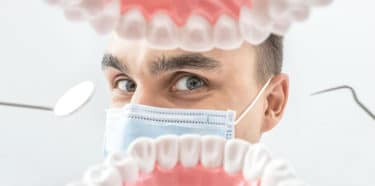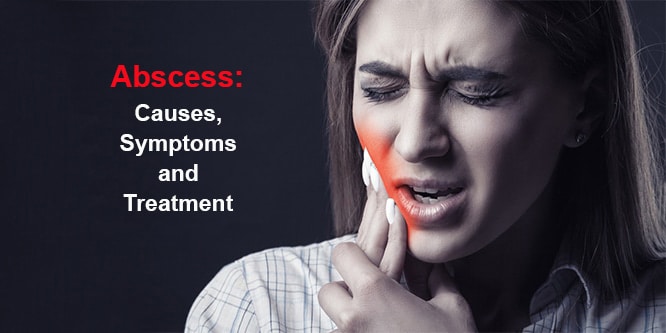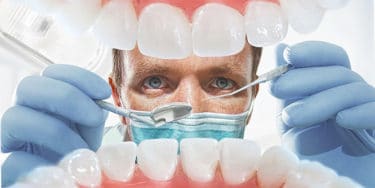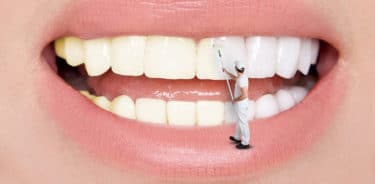Abscess is pus-filled sacs that are generally caused by bacterial infections. It can develop all over the body, but most commonly on the skin surface and teeth. Tooth abscesses can cause severe pain and swelling on the cheek. During treatment, painkillers and rinsing the mouth with saline, carbonated or hydrogen peroxide water may be helpful. Antibiotics are not preferred in the treatment of tooth abscesses unless there is a diffuse and severe infection. In order to find the cause of abscess and condition of the tooth, x-ray is taken and a treatment regime is administered accordingly. Usually, abscess is first drained and cleaned. Then, if tooth is recoverable, root canal treatment is administered, and if not, the tooth is extracted. If the treatment is neglected, it can cause serious health problems.
Table of Contents
What is abscess?
Abscess is a pus-filled sac that develops in body tissue and results from infection. It is red or pink in color, touch sensitive, warm and painful. Although it is mostly seen under the skin (skin abscesses), it can also develop in any organs or cavities among the organs. Tooth abscesses, in particular, can cause severe pain, halitosis, hot-cold sensitivity, and if left untreated, serious health problems.
Untreated abscesses get worse and can lead to life-threatening complications. Abscess can occur in the brain, kidney or other organs as a complication of an existing medical condition.
Why does abscess occur?
Most abscesses are caused by a type of bacteria called staphylococcus. When the bacteria enter the body, the immune system sends white blood cells to the affected area to fight infection. While white blood cells attack bacteria, they create a cavity filled with pus, causing abscess. It contains dead tissue, white blood cells, and bacteria.
Why do tooth abscesses occur?
Tooth abscess often occurs when soft pulp (dental pulp) tissue in root canal gets inflamed or dies as a result of an infection that developed in the tooth root or gums. (1)

Causes of tooth abscess
- Dental decay
- Broken, attrited, or injured in other ways
- Openings in tooth enamel
- Old fillings
- Gingival disease
Types of tooth abscess
The most common types of tooth abscess are:
- Periapical abscess: This abscess is occurred at the tip of the tooth root when bacteria invade the pulp. The dental pulp is the innermost part of the tooth that contains blood vessels, nerves, and connective tissue. It usually occurs as a result of an untreated dental cavity, fracture, or previous dental treatment. (2)
- Periodontal abscess: It is a type of abscess that develops in the gums near the root of the tooth. It is formed by the accumulation of bacteria as a result of food residue between the gums and the tooth. The abscess can also spread to the surrounding tissue and bone. The main reason is the neglection of dental care. Gum damage can also sometimes cause periodontal abscesses. (3)
- Gum abscess: It is an abscess that develops only in gums and does not affect teeth.
Symptoms of tooth abscess
- Shooting pain and severe pain (ear and jaw pain)
- Redness and swelling on the cheek
- Hot or cold sensitivity
- Pain while chewing or biting
- Change in tooth color
- Bright, red, and swollen gums
- Halitosis and taste loss
- Swollen glands of the neck or lower jaw
- Fever
- Difficulty in opening the mouth widely, swallowing or breathing
What helps tooth abscess pain?
- Painkillers: Painkillers can help relieve pain. The most effective painkillers are those with the active ingredients of ibuprofen and paracetamol. Those over the age of 16 can also take aspirin. However, do not place aspirin directly on the tooth with abscess, it can lead to aphthae.
- Clove oil: It is a natural painkiller. Pour a few drops of the diluted oil on cotton and press for 2-3 minutes on the aching tooth. After removing the cotton, wait another 10 minutes and rinse your mouth with warm water. You can also gargle by adding a few drops of clove oil to a small glass of water.
- Garlic: Garlic, a natural antibiotic, can kill bacteria and relieve pain. Crush a fresh clove of garlic and rub on tooth with abscess. When pain relieves, rinse your mouth.
- Cold compress: It can relieve pain and reduce cheek swelling. Put ice cubes in a bag and wrap it with a dry cloth, then hold it without pressing on the swollen cheek. You can apply it every 15 minutes.
Furthermore, rinsing the mouth with rock salted, carbonated or hydrogen peroxide water that have antibacterial function can temporarily relieve the tooth abscess. The measures should be:
- Salt water: Half a teaspoon of rock salt in half a glass of warm water
- Carbonated water: A pinch of salt and half a tablespoon of carbonate in half a glass of warm water. (4)
- Hydrogen peroxide (oxygenated water): Mix a coffee cup of warm water and equal amount of oxygenated water (the mixture should never be swallowed)

Tooth abscess treatment
A dental x-ray is taken first to determine the situation of the abscessed tooth and whether the infection spread to other teeth. Depending on the type and severity of abscess, the following treatments are usually administered:
- Abscess drainage: A small incision is made to the abscess so that the pus flows out. After the pus is completely drained and swelling taken down, the abscess area is cleaned with saline solution. After this process, root canal treatment is usually administered to save the tooth.
- Root canal treatment: First, the upper part of tooth is drilled with a drill to reach the root of the tooth. Damaged tissues (pulp) are removed and root canals are thoroughly disinfected to prevent the risk of recurrence of the infection. Then the root canal and pulp chamber are filled and closed. If necessary, the tooth can be covered with a permanent crown.
- Tooth extraction: If the abscessed tooth cannot be saved, it must be extracted. The cavity formed after tooth extraction is thoroughly cleaned and disinfected. Implant treatment can be administered to fill the missing tooth.
These treatments are administered under local anesthesia. Antibiotics are prescribed only if the infection spreads or if the patient has a weak immune system. In recurrent abscesses, it may be necessary to remove the infected tissue by surgical intervention under general anesthesia. This surgery is performed by an oral surgeon. In the abscesses of the gums, pus in the relevant area is thoroughly drained. The gums and root surfaces of the tooth are cleaned completely and disinfected to prevent recurrence of abscess.
How long does tooth abscess pain last?
Toothache completely goes in a few days after treatment.
Treatment of other abscesses
- Antibiotics: It can be prescribed to clean the infection and prevent its spread.
- Drainage: The incision is made to the abscessed area under local anesthesia. Then, the pus is drained by needle drainage.
- Surgical intervention: When it is not possible to drain the pus by needle drainage, especially in internal abscesses, surgical intervention may be required. Surgery under general anesthesia may vary depending on the type of abscess and place of body.
What is an abscess burst?
Abscess burst is a spontaneous burst of the abscess due to physical factors. While the abscess grows larger, the possibility of the burst increases and causes discharge. When the tooth abscess bursts, the pain suddenly goes and a bitter taste is felt in the mouth due to the flowing pus. This situation may lead to contamination of other teeth by the pus and spread the infection.
Furthermore, abscess formation may be relapsed as the bacteria may still be present in the abscess area. Therefore, you should immediately see the dentist when abscess bursts. The precautions that can be taken when tooth abscess bursts are:
- Clean the mouth thoroughly with plenty of water
- Frequently gargling with salt water
Complications of untreated tooth abscess:
- Loss of the tooth
- Blood infection (septicemia)
- Spread of infection to soft tissue and/or the jaw bone
- Spread of infection to the body (which can cause brain abscess and pneumonia)
Home remedies and for tooth abscess
- When tooth abscess occurs, make an appointment to see your dentist to avoid complications such as tooth loss.
- Avoid hot-cold foods and beverages. Try eating warm and soft foods.
- Do not consume anything sweet.
- Do not use your abscess tooth while eating.
- Brush your teeth with a soft toothbrush and temporarily do not floss around the abscessed tooth.
- Never try to burst tooth abscess yourself. This can cause infection to spread and/or to mix with blood.




